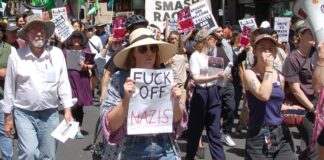Football fields, baseball pitches and basketball courts across the US have transformed into the latest political battlegrounds against racism, police violence and President Donald Trump.
This began during the 2016 NFL pre-season when San Francisco 49ers quarterback Colin Kaepernick sat down (and later started kneeling) during the pre-game national anthem. Kaepernick was responding to the systemic racism and police brutality that gave rise to the Black Lives Matter movement, saying:
“I am not going to stand up to show pride in a flag for a country that oppresses black people and people of color…There are bodies in the street and people getting paid leave and getting away with murder.”
Underscoring Kaepernick’s stand, less than a month later two black men were murdered by police. Terence Crutcher was unarmed and his killer, an Oklahoma police officer, was acquitted in May this year. Keith Lamont Scott had a brain injury and was waiting in his car for his son. The courts found that his killer, North Carolina officer Brentley Vinson, had used justifiable force.
Kaepernick’s football jersey became the country’s top seller. But after leaving the 49ers, he’s remained unemployed for his protest. Now hundreds of players have joined in sitting out, kneeling down and staying in their lockers rooms during the pre-game national anthem.
Trump fuels the fire
In September Trump raised the stakes during a speech in Alabama, calling NFL protestors “sons of bitches” and demanding they be fired.
Football is the most widely watched sport in the United States. In 2011 an estimated 64 per cent of Americans watched NFL broadcasts. So what happens in the stadiums matters.
More than 200 players hit back at Trump. Many were livid at the fact that Trump abused black footballers just weeks after defending protestors at the white supremacist rallies in Charlottesville as “very fine people.”
The Philadelphia Eagles raised their fists during the anthem. The Seattle Seahawks and the Tennessee Titans stayed in their locker rooms. Women’s soccer and basketball players joined the fray, as did college and high school football teams (and even their marching bands) in Florida, Virginia and South Carolina. Major league baseballer Bruce Maxwell knelt to a standing ovation from the crowd.
The NFL owners are trying to claim this as a marketing opportunity about the possibilities for national unity through sport. This is particularly hard to stomach in an industry where 70 per cent of players are black, while the white billionaire team owners contributed $7.75 million to Trump’s election campaign.
There has also been a backlash. The owners of NASCAR, the auto-racing conglomerate, said drivers and employees who don’t stand during the anthem should be fired—and deported.
Anthems at the game
Every sports game and NASCAR race in the US begins with the national anthem. Singing of the Star Spangled Banner surged during the First World War. Athletes were being drafted into the military, and some people questioned why players were on sports fields rather than battlefields. Usually players remained in their locker rooms during the singing.
It wasn’t until 2009 that prime-time players were mandated to stand during the national anthem. The policy was designed to bolster support for the US wars in Iraq and Afghanistan. The Department of Defense spent $6.8 million between 2012 and 2015 to promote these patriotic displays. In 2013 the Atlanta Falcons were given a $315,000 marketing contract in exchange for inviting 80 members of the National Guard onto the field holding a giant American flag. Last year the season opening coincided with the September 11 anniversary. Every stadium had troops marching, flags waving, warplanes overhead, and even real-life bald eagles.
Feeding the resistance
With every childish tweet, Trump pulls more people into the resistance. Kaepernick’s protest began a year ago and the actions had begun to subside. Now the protests are impossible to ignore.
We may not usually look toward sports stadiums for political direction. But we should remember the 1968 Mexico Olympics, when Tommie Smith and John Carlos raised their fists for black power on the podium, Australian runner Peter Norman standing next to them with a solidarity badge.
A year earlier boxing champion Muhammad Ali was stripped of his title for resisting the Vietnam War draft. These were moments that reflected a widespread mood for change and helped force racism and war into the political spotlight.
Instead of kneeling, players are now standing with locked arms during the national anthem. This suggests the national unity under the anthem that Trump and the team owners would prefer. But the protests have been another powerful example of the anger against Trump and the potential for new movements against racism and all that he stands for.
By Sofia Donnelly





